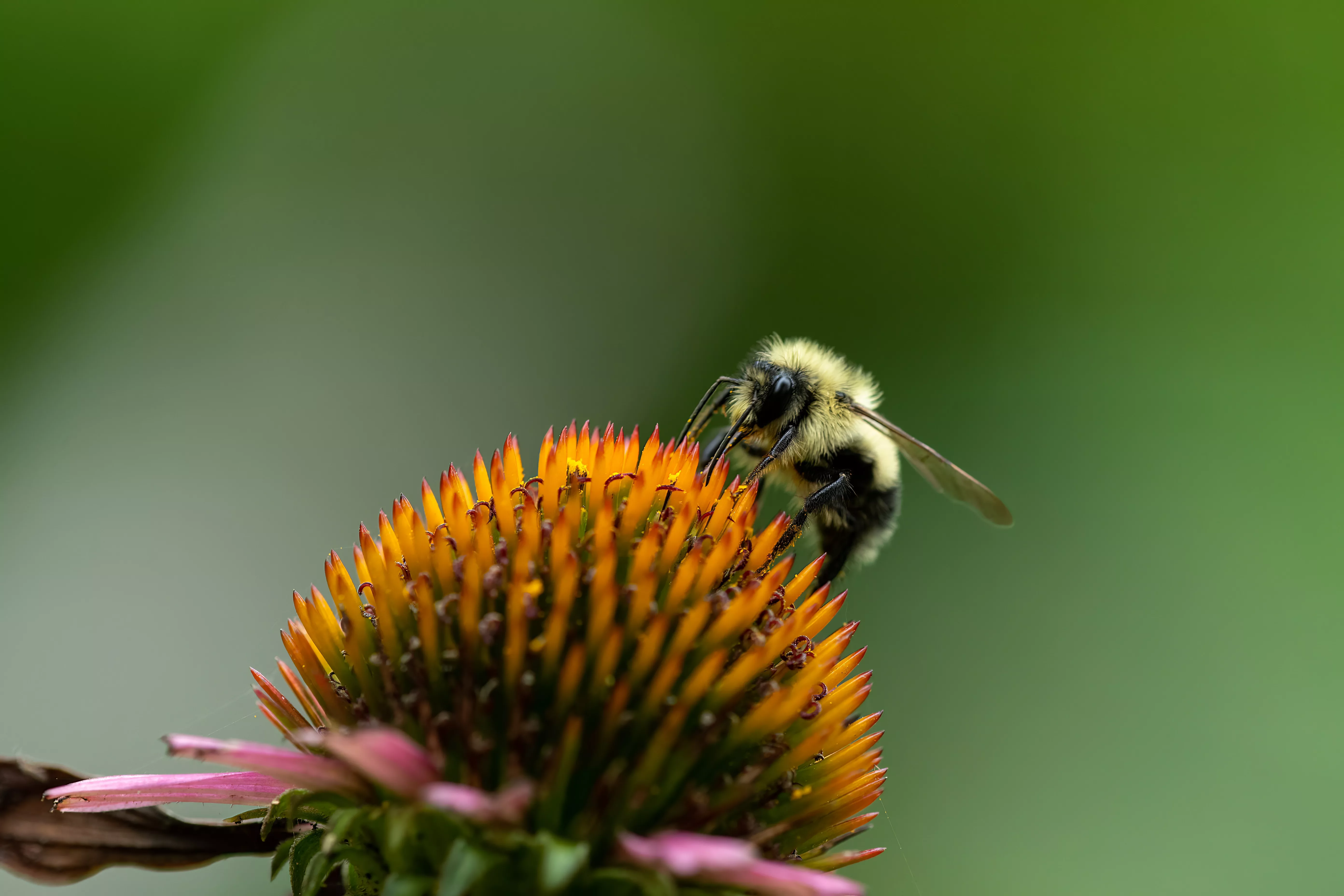
A bumblebee goes about its business on a prairie wildflower. DEO Photo by Seth Owens/NDPF.
By Seth Owens
Before dawn, as the sun paints the horizon with strokes of indigo and purple, the prairies of North Dakota awaken to a symphony of life. Amidst the rustling grasses and the whispering wind, intricate interactions unfold between pollinators and wildflowers, setting the stage for nature’s harmonious collaboration.
In this web of life, pollinators play a vital role as they flit, buzz, or crawl from flower to flower, orchestrating the essential act of pollination. Among the ensemble of six-legged locomotion, we find an array of common pollinator insects, each contributing their unique notes to the prairie’s symphony.
One of the most familiar performers are the honeybees, diligently collecting nectar and pollen from the vibrant prairie wildflowers. With their golden stripes glistening in the morning light, these industrious workers facilitate the cross-pollination necessary for the reproduction of various plant species. Hovering nearby, the Eastern tiger swallowtail butterfly (Papilio glaucus) gracefully dances among the blossoms, its vivid yellow wings and bold black stripes adding a touch of elegance to the prairie’s tableau.
As the sun ascends higher in the sky, the prairie comes alive with a medley of colors. Blankets of purple coneflowers sway gently, beckoning the attention of bumblebees and solitary bees. These fuzzy visitors, with their tireless buzz, collect pollen with utmost efficiency, ensuring the continuation of these resilient prairie plants.
Amidst the floral congregation, the delicate petals of the wild bergamot attract the admiration of the vibrant hummingbirds. Their iridescent feathers glinting with shades of emerald and ruby, these tiny avian gems become nature’s aerial acrobats, zipping from one nectar-filled bloom to another with unmatched agility.
But what significance do these pollinators and wildflowers hold beyond their intrinsic beauty? The answer lies in the interconnectedness of ecosystems, where every actor has a role to play. Just as the dancers on a grand stage depend on each other for the success of their performance, so do these prairie inhabitants.
Prairie pollinators, through their tireless efforts, ensure the reproduction of wildflowers, sustaining the delicate balance of the ecosystem. And in doing so, they provide vital food sources for upland gamebirds, such as pheasants and grouse, adding yet another layer to this intricate tapestry of life.
For the pheasant, the prairie wildflowers serve as both a visual feast and a pantry of insects. As pheasant chicks grow, they rely on the abundance of protein-rich insects found among the petals and leaves. Similarly, the sharptailed grouse finds nourishment amidst the prairie’s floral bounty, sustaining their populations and contributing to North Dakota’s upland gamebird community.
I frequently walk through these prairie landscapes, and with my senses immersed in the sights, scents, and sounds of this enchanting symphony, I can’t help but marvel at the intricate web of life that unfolds before me. Every pollinator and every wildflower holds a vital role, a small, but crucial thread that weaves together the prairie’s tapestry
The heartbeat of North Dakota’s prairies thrives in this delicate balance, where pollinators and wildflowers intertwine. So, we must embrace the beauty of this quilted landscape, and ensure that these precious ecosystems and their charismatic inhabitants perpetuate a legacy for generations to come.
For those fortunate enough to witness this grand performance, it becomes an everlasting connection to the land. These experiences instill a profound appreciation and deep connection to the wonders of our natural world. Venture forth, like explorers in the sea of grass, guided by the melodic whispers of the prairie wind, and forever cherish the magnificence of our prairie pollinators and wildflowers.
Seth Owens is a Dakota Edge Outdoors contributing writer and the Education and Outreach Coordinator for North Dakota Pheasants Forever.
